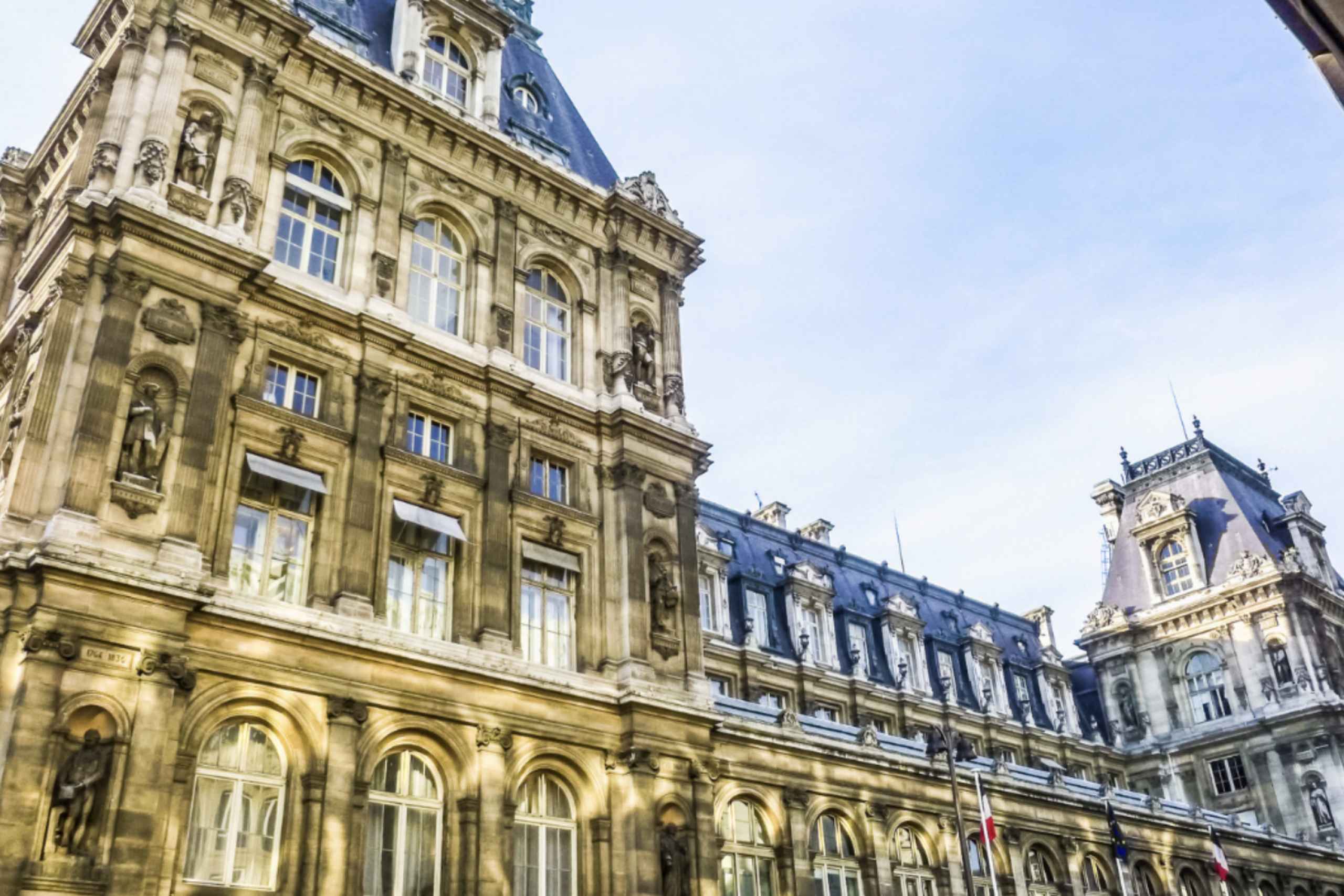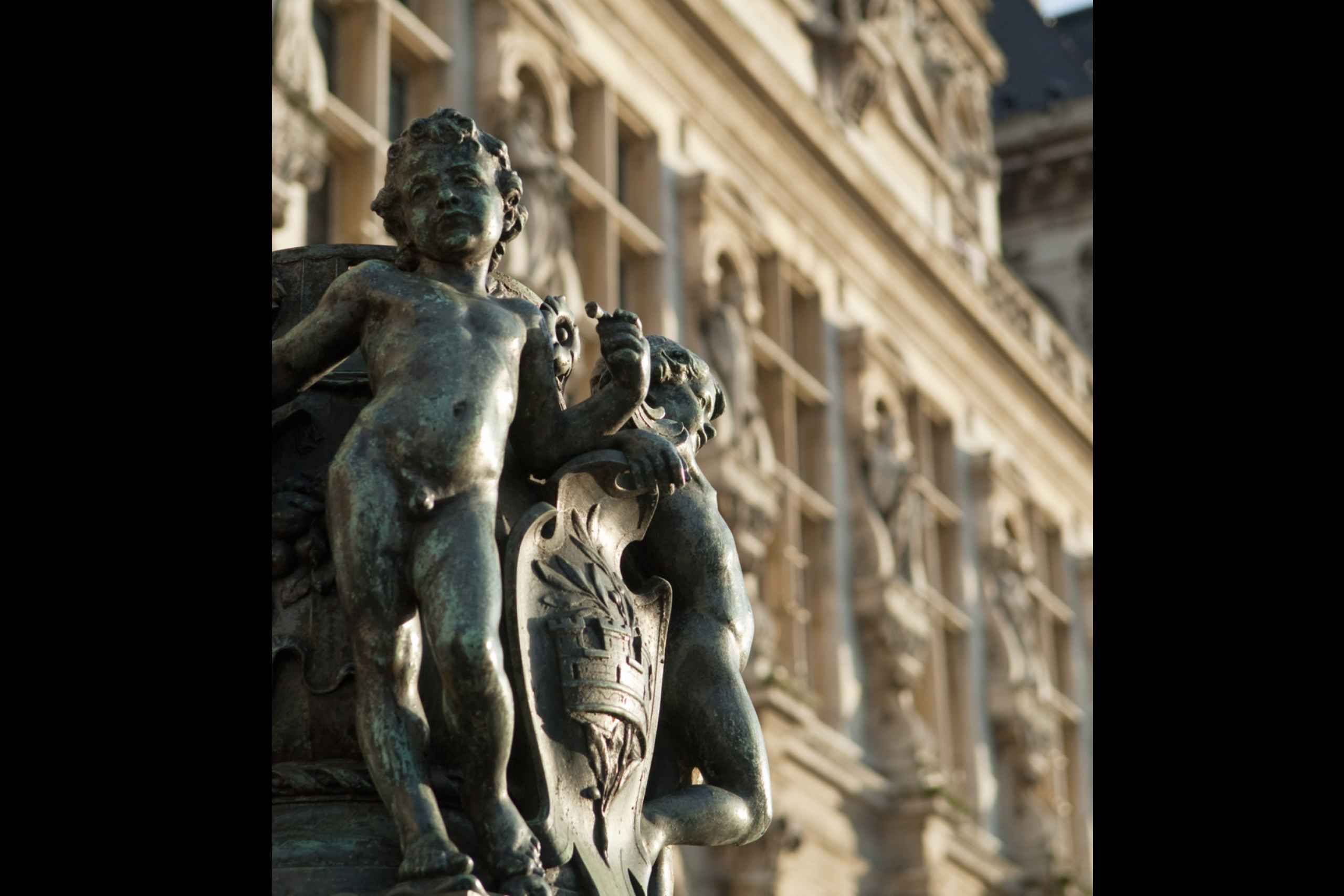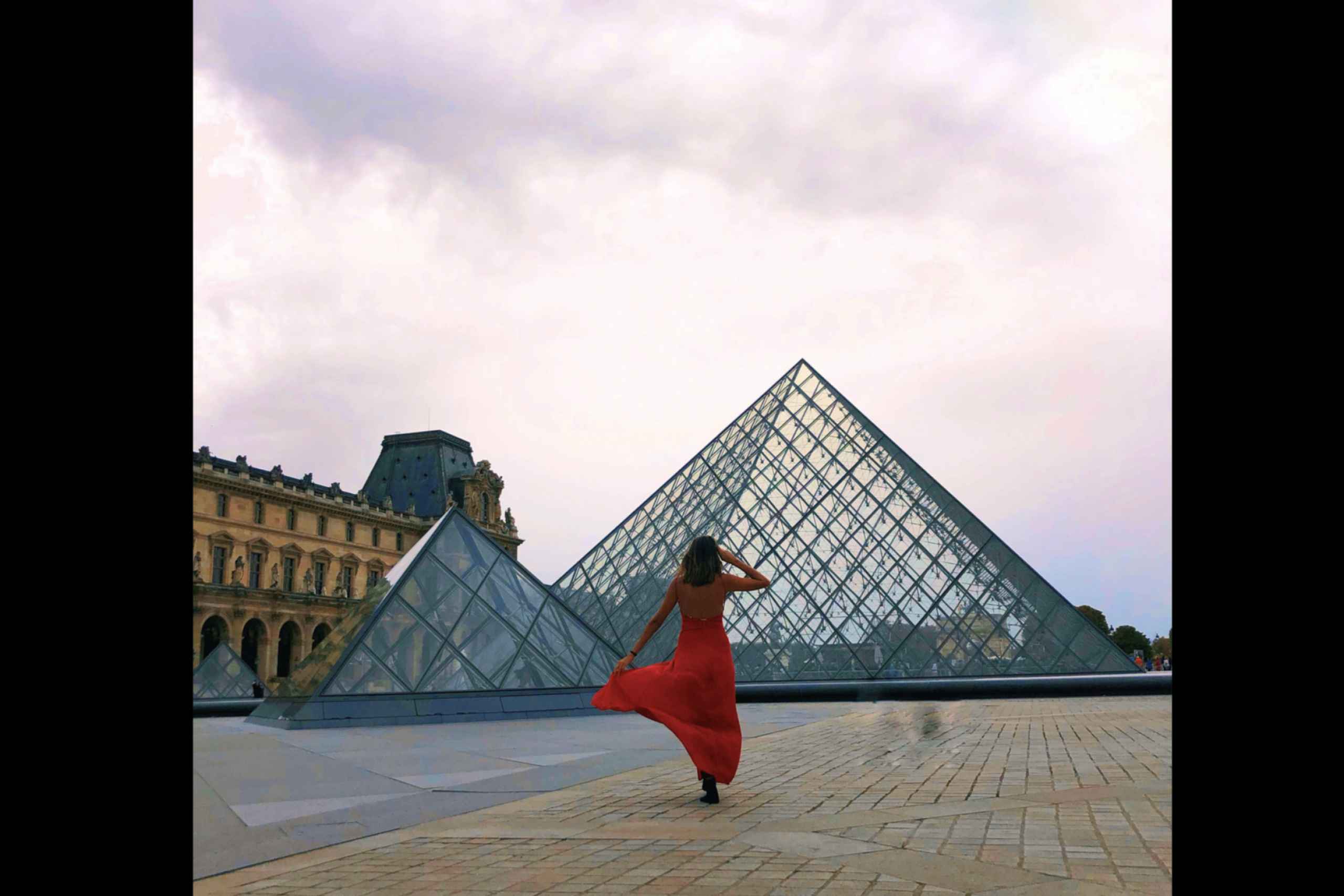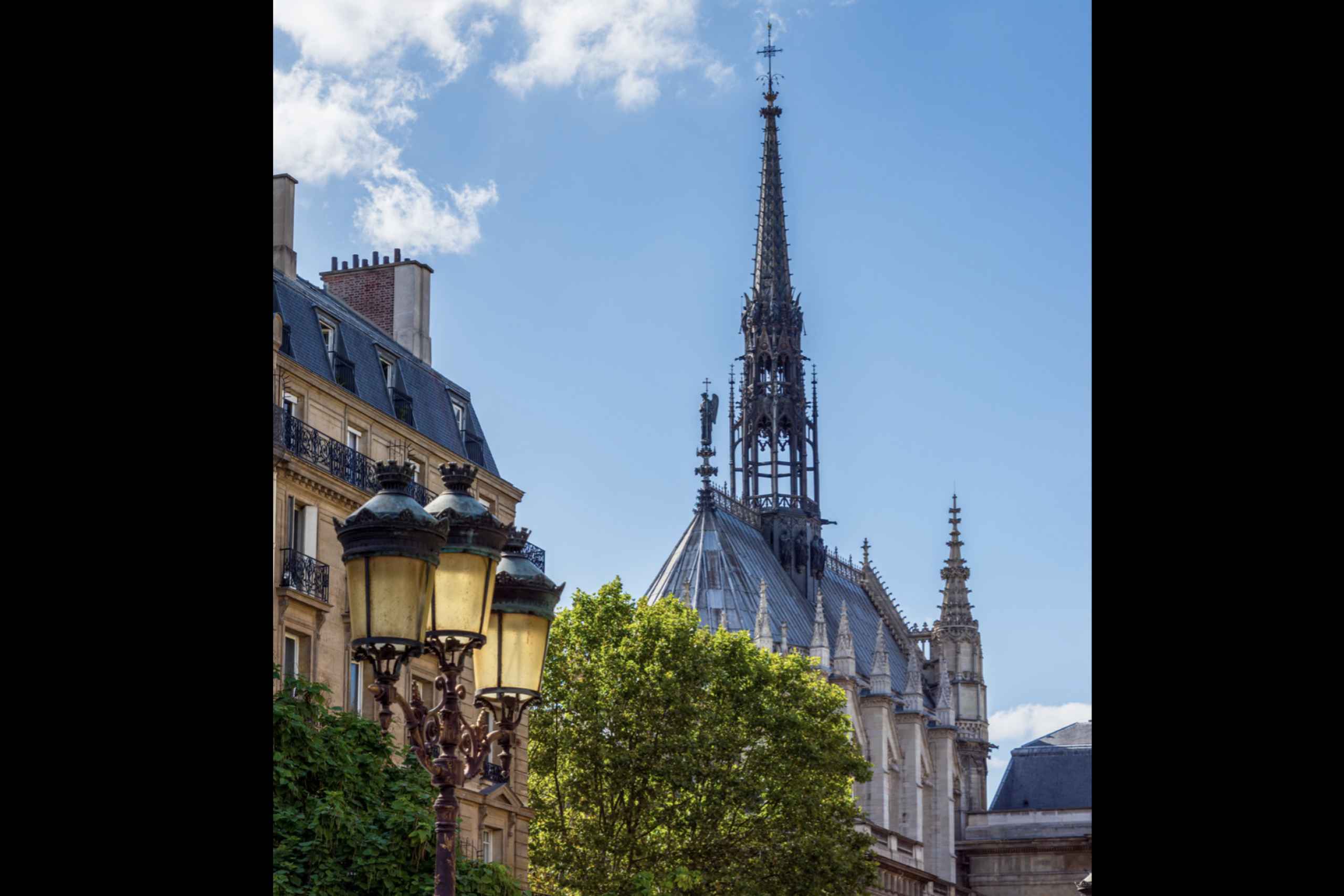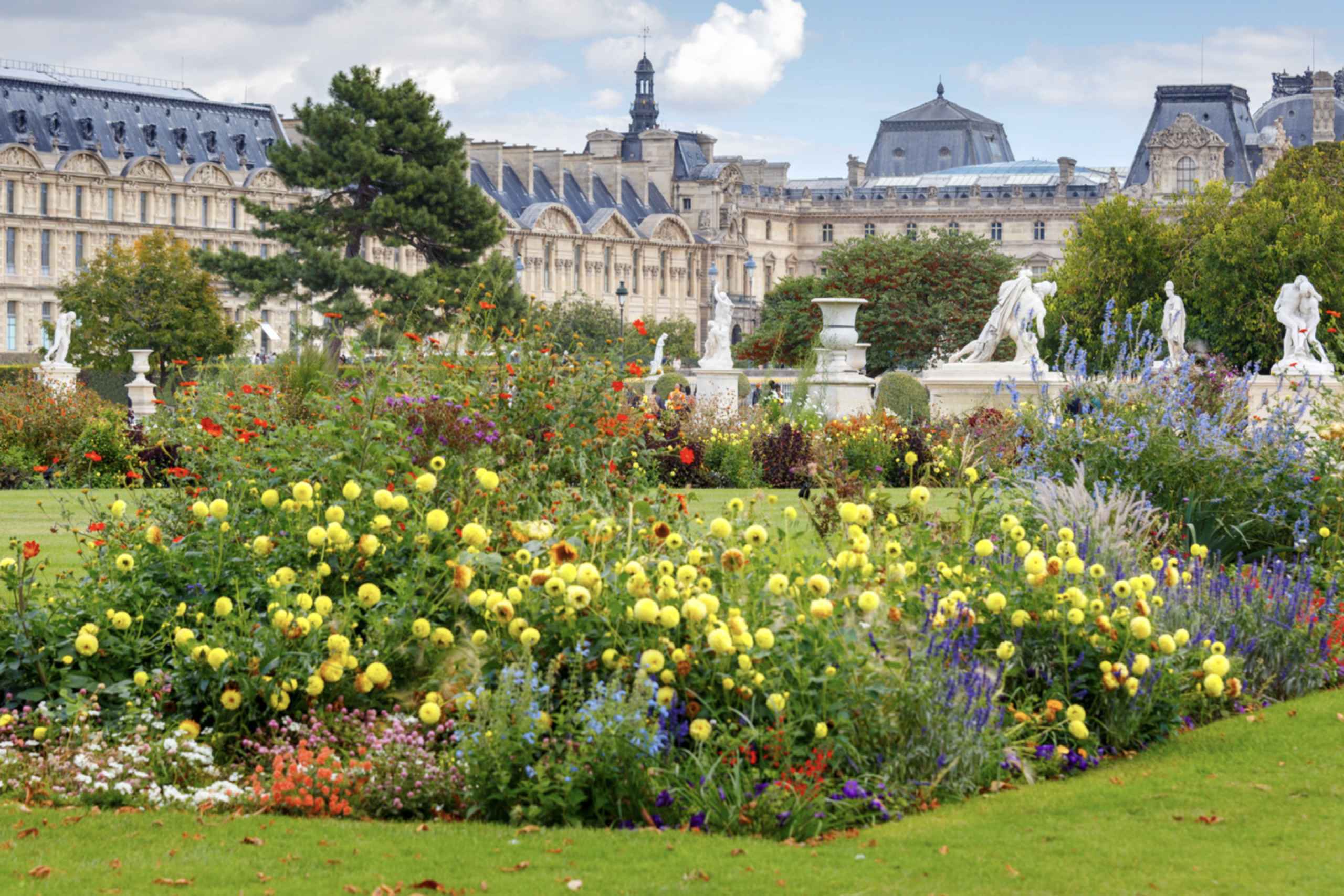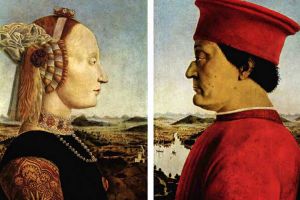An excellent introduction to the City of Lights, this 4-hour walking tour puts you right in the heart of it all!
- Stand in the elegant Napoleon Courtyard
- Admire The Arc of the Carrousel and the Tuileries Gardens
- Discover the Age-Old Traditions and Modern Glamour in the Marshes of Le Marais
- Stroll along the banks of the River to the Medieval Marvels of Île de la Cité
- Wander through the chambers of Sainte-Chapelle
Pyramids at a Princely Palace
The Louvre’s grand courtyard, once home to French kings, is framed by Baroque façades. Visitors queue, locals sip champagne, and children play near fountains. I.M. Pei’s glass pyramids rise among the old stone, uniting past and future. Napoleon’s Arc de Triomphe du Carrousel leads to the elegant Tuileries Gardens, once created for Queen Catherine de Medici.
Tradition and Glamor in Le Marais
Le Marais, once swampy land, became Paris’ stylish center in the 1600s. Today, it blends the grandeur of the Hôtel de Ville with the playful modernism of the Centre Pompidou. Now a lively LGBTQ+ hub, it thrives with chic cafés, clubs, and street food.
The Île de la Cité
Cross the Seine to this medieval island, home to Notre-Dame, Sainte-Chapelle, and the Conciergerie. Once a royal palace, it still echoes with legends of knights, love, and faith.
“There are only two places in the world where we can live happy,” Ernest Hemingway declared, “at home and in Paris.” Hemingway knew how to access the energy and recognize the natural warmth and generosity of the spirit of Paris. Take a stroll in the company of your Licensed Professional Guide on this half-day discovery of the city center, encountering the key elements of her history, her humor and her heart.
Pyramids at a Princely Palace: The Napoleon Courtyard at the Louvre
Stand in the elegant embrace of the mighty arms of the Louvre, the principal residence of France’s kings for more than 2 centuries. Majestic Baroque façades watch over the courtyard, where visitors queue for the museum, local business people enjoy a glass of champagne in the sun, and children frolic and cavort among the fountains. Scattered across the grand courtyard are the glass and steel pyramids designed be world-renowned Chinese American architect I.M. Pei, reminding us of the need to be solidly rooted to the past while inspiring us to venture ever more boldly into the future.
The Arc of the Carrousel – a testament to the ambitions and achievements of Napoleon Bonaparte – serves as a gateway to the rolling lawns and gravel paths of the Tuileries Gardens. Once part of the royal estate, these spectacular Renaissance gardens were designed for Queen Catherine de Medici in the 16th century. Now anyone can amble along, admiring seasonal flora and timeless statuary, smiling at youngsters maneuvering their miniature sailboats over the glittering surfaces of the park’s various pools. This is also where the famed Champs-Elysées begins its westward march toward the Arc de Triomphe, the big brother to that of the Carrousel.
Age-Old Traditions and Modern Glamor in the Marshes of Le Marais
Originally developed by monastic orders in the 12th century on what were then the swampy outskirts of town, Le Marais quarter in the early 1600s was the place to see and be seen. King Henry IV had expensive town homes built around an expansive square, the very first in the city, and the crème de la crème of the aristocracy moved in and took up residence. The French Revolution brought an end to the dreamy days of the urban élite here, and the area was opened to all. In honor of the first of the provinces to pay taxes to the new Revolutionary régime, the square received the name it still bears today – Place des Vosges – and now all Parisians can enjoy the sprawling lawns and arbored avenues of what remains one of Paris’ most elegant addresses.
Le Marais is where Paris’ spectacular Hôtel de Ville, or City Hall, is located. The magnificent façade reflects the grand ideals of the French Renaissance, embellished by architectural elements of France’s Classical period. Not far away is a testament to the city’s playful side: the Centre Pompidou. Formally named after the French president who envisioned and commissioned this beacon of artistic experimentation, locals more commonly call it Beaubourg, after the surrounding neighborhood. In constant evolution, the Centre Pompidou never fails to inspire and delight.
Le Marais first became home to Paris’ growing Jewish population in the 1200s. Around the turn of the 20th century, successive waves of Jewish immigrants arrived, fleeing misery and persecution in Eastern Europe. This eclectic community still thrives in the area around Rue des Rosiers, and the Place Saint-Paul, known as the Pletzl (little square in Yiddish), where you will find synagogues, discreet gardens, Hebrew schools and kosher food stands frequented by black-clad men and boys and demurely-dressed women and girls, alongside other neighborhood residents and well-informed visitors.
More recently, Le Marais has established itself as the fashionable haven of the City of Lights’ LGBTQ+ communities. Slick clubs, trendy bars, chic cafés, and dining experiences that range from très sophistiqué to the bit-and-run street food provide all the stylishly social needs of Gay Paris’ bourgeois Bohemians. This eclectic mix of old and new, of tradition and experimentation, of easy camaraderie and mutual affection and respect is right at home in Le Marais.
* Food is always a good idea, although it's not included in this tour and its pricing please let our office team know if you are interested in enjoining some nibbles in the wonderful Le Marais neighborhood. We will give you some options and the surcharge for this option.
The Île de la Cité: the Medieval Marvels of the Conciergerie, the Sainte-Chapelle and Notre-Dame
A short stroll along the banks of the River Seine brings you to the bridge you will cross to the Île de la Cité. It is here that the ancient Romans erected their garrison town, and it is here that, in the 6th century, the Frankish kings established their residence. Part of the Medieval Palais de la Cité still stands today in the Conciergerie, whose turreted towers and cone-capped bastions stood guard as bards regaled the royal household with epic tales of heroic knights and daring damsels who risked it all for love and honor nearly a millennium ago. That grand palace was expanded in the 13th century by King Louis IX – later to be canonized as Saint Louis – with the construction of a magnificent chapel, one fit to hold such sacred relics as Christ’s crown of thorns. The Sainte-Chapelle’s upper chamber features walls of windows that are 50 feet (15 meters) high, with more than 2000 square feet (185m²) of stained glass, constituting one of the world’s most important examples of this High Medieval art from.
No visit to Medieval Paris – or Paris tout court – could possibly be considered complete without a few moments in the ethereal air of the Cathedral of Notre-Dame. The sound of her bells has engendered legends, the sight of her towers has brought men to their knees. To cross her threshold is to step into the embrace of a thousand years of fear and faith, yearning and seeking, ambition, achievement and identity. The hushed awe that prevails is broken only by the inevitable gasps of astonishment and wonder. Her ribs reach high into the heavens, pointing us toward the eternal that resides in each of us, as the sun streaming through ink-stained windows brings age-old stories to brilliant life, illuminating the stones, the space, and our very souls.
Through Eternity’s Essential Paris Tour brings you face-to-face with this remarkable city, as our Expert Local Guide unlocks her secrets and tells you her tales.
- Expert, English-speaking private guide.
- Expedited entrance tickets.
- Headsets (for groups of 6 or more).
- Transportation to and from the meeting and end points
- Food and beverages
- Gratuities (optional)
- As this is a walking tour through different areas of the city with steps and uneven walkways, comfortable walking shoes and a bottle of water are strongly recommended.
- Please advise if there are any travelers with mobility concerns so that we can best accommodate you.
- Our guide will meet you at Place de la Concorde outside Tuileries, next to the Luxor Obelisk. They will have a Through Eternity sign.
- Please ensure you arrive 10 minutes early and at the right meeting point. If you are unable to find your guide by 10 minutes before the starting time, please call our office at +1 800-267-7581.
- As this is a walking tour, comfortable walking shoes and a bottle of water are strongly recommended.
- Please advise if any travelers have mobility concerns.
- The ages of any children joining the tour are required. Upon booking, please email the ages of all children traveling with you to [email protected].
- All churches have a dress code that requires visitors to keep their shoulders and knees covered. You may risk refused entry should you not comply with the dress code.
- The cost of the tour includes entrance tickets and the cost of the guide. Food and drinks fees are not included. The cost of the tour does not include gratuity for the guide.
Cancellation Cutoff: 15 days
Cancellation Notes: 15 or more days before the tour day: 90% of the cost will be refunded, minus ticket costs; Between 8 and 14 days before the tour day: 50% of the cost will be refunded, minus ticket costs; 7 days or less: no refund.
| Essential Paris: Walking Tour with Ile de la Cite | RETAIL PRICE |
|---|---|
| Adult (18 - 64 years) | $425.00 |
| Child (5 - 11 years) | N/A |
- Place saint Paul, Place Saint-Paul, Liège, Belgium
- Hôtel de Ville, Place de l'Hôtel-de-Ville, Paris, France
- Basilique du Sacré-Cœur de Montmartre, 35 Rue du Chevalier de la Barre, 75018 Paris, France
- Pompidou Center, Paris, France
- Notre-Dame Cathedral of Paris, Parvis Notre-Dame - Place Jean-Paul-II, Paris, France
- Le Marais, Rue Vieille-du-Temple, Paris, France
- Louvre Pyramid, Paris, France
- Place des Vosges, Place des Vosges, Paris, France
https://www.througheternity.com/en/terms-and-conditions.html
Tickets will be held at the box office
